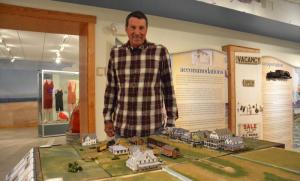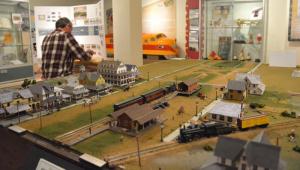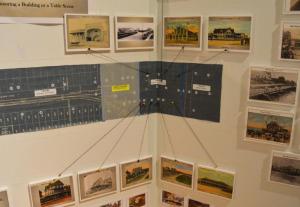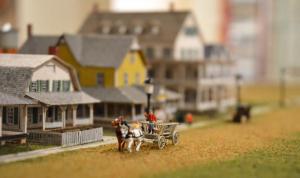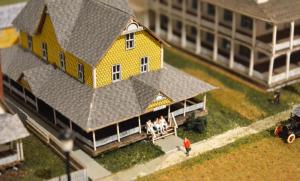Paul Lovett: re-creating Rehoboth Avenue buildings, rail system from 1910
Rehoboth’s Paul Lovett said he began re-creation of Rehoboth Avenue circa 1910 for a simple reason.
“I wanted to know what stuff looked like on Rehoboth Avenue back in the day, and it really began to get under my skin,” said Lovett, in the Rehoboth Beach Museum, looking over a diorama he has begun working on.
Titled “The Golden Age of Rehoboth: the Railroad Era,” Lovett’s diorama was recently at the museum for a presentation and discussion on the city’s early history. It was very well attended, he said.
Lovett, 72, has spent all of his life a stone's throw from the Lewes-Rehoboth Canal. His family has owned the Oak Grove property on the east side of the canal on Canal Street since the 1950s, when it was Oak Grove Motor Court.
Since the late 1990s, he and his wife Cindy have owned the property on Rehoboth Avenue where the restaurant Egg, formerly McQuay’s Marketplace, is located. Using the building of the museum, which used to be an ice house, a cannery across the canal, and the McQuay’s building as examples, Lovett said he became interested in the history of Rehoboth Avenue. He began to think about why there was a need for the buildings that line the canal and Rehoboth Avenue.
“These buildings were there and old when I was young, and I wanted to know when things were so vibrant that people would invest in these buildings. It was during the railroad era,” said Lovett. “Rehoboth Avenue was as busy in 1910 as it is today, and it’s all because of the railway.”
Lovett explained how twice a day the train would come from Lewes, make its way down Rehoboth Avenue, drop passengers off and then head back west beyond the canal to turn around on the system’s switching yard. It was like a big K-turn, he said.
Lovett said two things killed the use of train passenger service in Rehoboth – one was the Great Depression – but mostly it was cars. By the 1950s, the train service was totally gone, he said.
Lovett said he’s hired professional model builders to make the structures, which are made of paper, cardboard and wood. The detailed diorama includes miniature people, horses, buggies and other details of life from the early 1900s. He said now that he knows how long the structures take to make, he anticipates he won’t be done for the next couple of years. When it’s done, he said, he’s probably just going to give it to the museum.
“I want people to see it,” he said. “What good is it going to do me?”
The completed section of the diorama, from First Street, east about half a block, has taken Lovett a little over a year to complete. All the buildings are historically accurate, he said. The missing piece for this section, a huge merry-go-round, was just finished, Lovett said, and it will be installed as soon as the diorama makes its way back to his home.
Lovett said the next section he’s going to build is the portion of Rehoboth Avenue closest to the Boardwalk and then the beach section, which will include Horn’s Pavilion, a fishing pier that went out over the Atlantic Ocean.
Lovett said the diorama won’t include a small section of the western end of Rehoboth Avenue because it would simply get too big, and he wants to make sure the switching yard west of the canal is included.
When the diorama is fully completed, Lovett said he envisions a working train station, with a sound and light show, with smoke and whistles.
Lovett said he’s looking for sponsors to help with the future portions of the diorama. To sponsor a building, contact Lovett at 302-893-9391 or email him at paul@pdlovett.com.
Chris Flood has been working for the Cape Gazette since early 2014. He currently covers Rehoboth Beach and Henlopen Acres, but has also covered Dewey Beach and the state government. He covers environmental stories, business stories and random stories on subjects he finds interesting, and he also writes a column called Choppin’ Wood that runs every other week. He’s a graduate of the University of Maine and the Landing School of Boat Building & Design.















